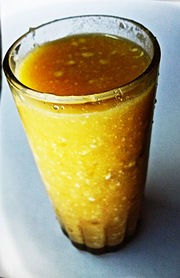Pana Sankranti
is an important day in Odisha. As
per solar method, Surya (Sun) transits to Mesha rashi (constellation Aries) a
on this day and is over Visubha rekha (Equator). The day heralds the solar month
of Mesha per Hindu calendar. Hence, the day is also known as Mesha sankranti,
Maha vishubha sankranti and Meru sankranti. Odiyas observe beginning of their
New Year on this day because of its astronomical significance. It also marks
the onset of ensuing summer season.
On this
day, religious people get up early in the morning and take sankranti buda (bath) in nearby rivers/ponds. Standing in knee deep
water they worship Surya reciting Gayatri
mantra. Some perform homa (worship
before fire). They spend the day visiting temples Many keep upabasha (fast) while others take simple
vegetarian food.
As said before,
it marks the onset of summer in the region rendering the people thirsty.
Therefore, benevolent people offer pana
(cold sweetened water to the thirsty. It is also served to friends and
relatives as a gesture of goodwill. Though the pana is supposed to be sweetened water, it is usually made of pulp
of bela (wood apple), nadia kora (coconut gratings) chena (cottage cheese), etc. seasoned
with ginger and black pepper. Because of offering of pana on this day, the sankranti
is commonly known as Pana sankranti.
 Panna
Panna
Another
feature of Odiya celebration is the worship of plants in general and tulashi in particular.
It is
needless to say that in every Odia Bela pana - a sweet drink served on this
occasion. Every home has a tulashi
plant in tulashi chaunras (a small
temple shaped flower pot) in the front courtyard. Odiyas consider it as Maa
Brundabati or Tulashi personified. After visiting temples, they worship the
Tulashi in Chaunra.
In a
symbolic gesture to provide relief to
tulashi plant from the heat of the summer, a chhamundia (shed of leaves) is erected over the chounra to provide shade to the plant. A
small earthen pitcher with a hole at the bottom and filled with water or pana is hung over it. The hole allows
the mixture to flow down drop by drop over the plant. The theki is refilled with water or
pana every day during the entire month
 Tulashi plant
Tulashi plant
In the
Bhaviswa purana, the day is described
as Jala sankranti. It is mentioned
that during the legendary Mahabharata war, when Bhishma pitamaha (grand sire)
was lying on the sara sajjya (bed of
arrows) for eighteen days being grievously hurt and waiting for the auspicious
period of uttarayana yatra of Surya
to leave the mortal world, he felt thirsty and asked for water. As there was no water around the battlefield,
Arjuna, shot an arrow deep into the ground from his powerful bow and water came
out as a geyser. With it Bhishma pitamaha quenched his thrust. That day was
Mesha sankranti. Out of contentment, he blessed the Pandavas mentioning that
those who would offer water to the thirsty on this day would not only be freed
of their sins but also would free their pitru
purushas of their sins. This description in the Holy Scriptures is taken
with reverence and people offer cold sweet water or pana to the thirsty ones.
In many homes, traditional Odiya dishes, pithas are prepared and shared with friends and family members. In this way the day is spent enjoying and merrymaking.
A few festivals are associated with this sankranti.
The famous fortnight long Danda or Jhamu yatra observed in southern Odisha ends on this day. Devotees observing it walk on red hot ember as a penance. So great is their faith that their feet do not suffer from burn injuries. Many people gather to witness this.
In northern part of the state, Tribal people observe it as Meru yatra where in devotees pierce their body parts with sharp iron rods and move red hot ember as a penance. On this day, the fisherman community all over the state end their Chaiti festival. Hanuman Jayanti (birthday of Hanuman) is also observed on this day and temples are full of devotees. The tribals spend the day with great festivities, feasting drinking and dancing.
Author is retired colonel from the Indian Army.
To read all articles by author